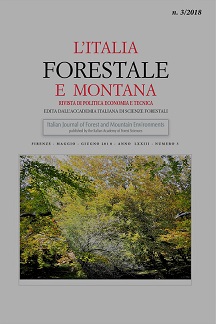Forest-wood chain analysis in the perspective of circular (bio)economy: the case study of Monte Morello forest
Published 2018-11-13
Keywords
- bioeconomy,
- circular economy,
- forest-wood chain analysis,
- woodchips,
- Tuscany Region
Copyright (c) 2018 Italian Journal of Forest and Mountain Environments

This work is licensed under a Creative Commons Attribution-NonCommercial 4.0 International License.
Abstract
Recently, the role of circular bioeconomy in order to increase the competitiveness of enterprises and economies of European Union (EU) member countries was emphasized. In circular bioeconomy, the forest sector has a key role with special regard to bioenergy production. The main aim of the present study was to analyze the forest-wood chain at local level (Monte Morello, Florence) following the circular bioeconomy approach. The study was divided in two steps: in the first step wood materials flow and carbon dioxide emission from the production process were analyzed; in the second step a set of indicators - specific for the forest sector - to quantify the 4R (Reduce, Reuse, Recycle, Recover) of circular economy was identified and tested. The following aspects were considered: improvement of production process efficiency; reuse and life-span of wood products; optimization of potential wood assortments; and energy recover from the wood products. The results showed that the forest-wood chain by thinning in the Monte Morello forest did not optimize the commercial wood assortments because all wood volume was allocated for bioenergy production. This aspect has generated a negative economic impact and reduced the life-span of wood products. Conversely, the results showed a favorable balance regarding the carbon dioxide emission - above all considering the fossil fuel substitution effect - and for the use for energy production of part of the great amount of deadwood of the Monte Morello forest.

